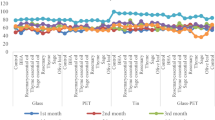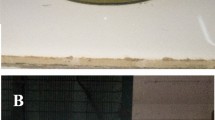Abstract
Active packaging is a promising technology for food industry. In this study, polylactic acid (PLA) films were prepared with dry or lyophilized plants of thyme and rosemary. These plants are an abundant, inexpensive source of polyphenolic antioxidant. Oil-in-water (O/W) emulsions were made, covered by the different PLA films and stored for 30 days. The lipid oxidation was measured by peroxide value and thiobarbituric acid-reactive substances assays. The lyophilized rosemary extract (LRE) and lyophilized thyme extract used in PLA films, resulted in enhanced oxidative stability of emulsions. PLA film with LRE was the most effective to protect of O/W emulsion at 33 ± 1 °C for 20 days according to guideline by the Codex Alimentarius (<10 meq/kg), regarding the control that exceeds this value to 5 days. The prepared PLA films were characterized to determine the effect of rosemary and thyme on thermal properties and thermo-oxidative stability of the films. In addition, the migration behavior was evaluated in contact with food simulants. PLA antioxidant active packaging could reduce the need of adding antioxidants directly in food products, increasing the shelf life.







Similar content being viewed by others
References
Cutter CN (2002) Microbial control by packaging: a review. Crit Rev Food Sci Nutr 42:151–161. doi:10.1080/10408690290825493
Boonnattakorn R, Chonhenchob V, Siddiq M, Singh SP (2015) Controlled release of mangiferin using ethylene vinyl acetate matrix for antioxidant packaging. Packag Technol Sci 28:241–252. doi:10.1002/pts.2097
de Araújo GKP, de Souza SJ, da Silva MV et al (2015) Physical, antimicrobial and antioxidant properties of starch-based film containing ethanolic propolis extract. Int J Food Sci Technol 50:2080–2087. doi:10.1111/ijfs.12869
Johnson DR, Tian F, Roman MJ et al (2015) Development of iron-chelating poly(ethylene terephthalate) packaging for inhibiting lipid oxidation in oil-in-water emulsions. J Agric Food Chem 63:5055–5060. doi:10.1021/acs.jafc.5b00796
Musioł M, Sikorska W, Adamus G et al (2016) (Bio)degradable polymers as a potential material for food packaging: studies on the (bio)degradation process of PLA/(R, S)-PHB rigid foils under industrial composting conditions. Eur Food Res Technol 242:815–823. doi:10.1007/s00217-015-2611-y
Wen P, Zhu DH, Feng K et al (2016) Fabrication of electrospun polylactic acid nanofilm incorporating cinnamon essential oil/β-cyclodextrin inclusion complex for antimicrobial packaging. Food Chem 196:996–1004. doi:10.1016/j.foodchem.2015.10.043
Hughes J, Thomas R, Byun Y, Whiteside S (2012) Improved flexibility of thermally stable poly-lactic acid (PLA). Carbohydr Polym 88:165–172. doi:10.1016/j.carbpol.2011.11.078
Frankel E (1998) Methods to determine extent of oxidation in lipid oxidation. The Oily Press, Dundee
Gallego MG, Gordon MH, Segovia FJ et al (2013) Antioxidant properties of three aromatic herbs (rosemary, thyme and lavender) in oil-in-water emulsions. J Am Oil Chem Soc 90:1559–1568. doi:10.1007/s11746-013-2303-3
Jamshidian M, Tehrany EA, Imran M et al (2010) Poly-lactic acid: production, applications, nanocomposites, and release studies. Compr Rev Food Sci Food Saf 9:552–571. doi:10.1111/j.1541-4337.2010.00126.x
Samsudin H, Soto-Valdez H, Auras R (2014) Poly(lactic acid) film incorporated with marigold flower extract (Tagetes erecta) intended for fatty-food application. Food Control 46:55–66. doi:10.1016/j.foodcont.2014.04.045
Colín-Chávez C, Soto-Valdez H, Peralta E et al (2013) Fabrication and properties of antioxidant polyethylene-based films containing marigold (Tagetes erecta) extract and application on soybean oil stability. Packag Technol Sci 26:267–280. doi:10.1002/pts.1982
Che Man Y (2000) Effect of rosemary and sage extracts on frying performance of refined, bleached and deodorized (RBD) palm olein during deep-fat frying. Food Chem 69:301–307. doi:10.1016/S0308-8146(99)00270-8
Nakatani N, Inatani R (1984) Two antioxidative diterpenes from rosemary (Rosmarinus officinalis L.) and a revised structure for rosmanol. Agr Biol Chem 48:2081–2085
Frankel EN, Huang S-W, Kanner J, German JB (1994) Interfacial phenomena in the evaluation of antioxidants: bulk oils vs emulsions. J Agric Food Chem 42:1054–1059. doi:10.1021/jf00041a001
del Baño MJ, Lorente J, Castillo J et al (2003) Phenolic diterpenes, flavones, and rosmarinic acid distribution during the development of leaves, flowers, stems, and roots of Rosmarinus officinalis. Antioxidant activity. J Agric Food Chem 51:4247–4253. doi:10.1021/jf0300745
Huang S, Frankel EN, Schwarz K, German JB (1996) Effect of pH on antioxidant activity of α-tocopherol and trolox in oil-in-water emulsions. J Agric Food Chem 44:2496–2502
Frankel EN, Huang S-W, Aeschbach R, Prior E (1996) Antioxidant activity of a rosemary extract and its constituents, carnosic acid, carnosol, and rosmarinic acid, in bulk oil and oil-in-water emulsion. J Agric Food Chem 44:131–135. doi:10.1021/jf950374p
Pangloli P, Melton SL, Collins JL et al (2002) Flavor and storage stability of potato chips fried in cottonseed and sunflower oils and palm olein/sunflower oil blends. J Food Sci 67:97–103. doi:10.1111/j.1365-2621.2002.tb11366.x
Gao Y, Gu Y, Wei Y (2011) Determination of polymer additives-antioxidants and ultraviolet (UV) absorbers by high-performance liquid chromatography coupled with UV photodiode array detection in food simulants. J Agric Food Chem 59:12982–12989. doi:10.1021/jf203257b
Andersson SR, Hakkarainen M, Albertsson AC (2012) Long-term properties and migration of low molecular mass compounds from modified PLLA materials during accelerated ageing. Polym Degrad Stab 97:914–920. doi:10.1016/j.polymdegradstab.2012.03.028
Bor Y, Alin J, Hakkarainen M (2012) Electrospray ionization-mass spectrometry analysis reveals migration of cyclic lactide oligomers from polylactide packaging in contact with ethanolic food simulant. Packag Technol Sci 25:427–433. doi:10.1002/pts.990
Conn RE, Kolstad JJ, Borzelleca JF et al (1995) Safety assessment of polylactide (PLA) for use as a food-contact polymer. Food Chem Toxic 33:273–283
Muriel-Galet V, Cran MJ, Bigger SW et al (2015) Antioxidant and antimicrobial properties of ethylene vinyl alcohol copolymer films based on the release of oregano essential oil and green tea extract components. J Food Eng 149:9–16. doi:10.1016/j.jfoodeng.2014.10.007
Iñiguez-Franco F, Soto-Valdez H, Peralta E et al (2012) Antioxidant activity and diffusion of catechin and epicatechin from antioxidant active films made of poly(L-lactic acid). J Agric Food Chem 60:6515–6523. doi:10.1021/jf300668u
Manzanarez-López F, Soto-Valdez H, Auras R, Peralta E (2011) Release of α-tocopherol from poly(lactic acid) films, and its effect on the oxidative stability of soybean oil. J Food Eng 104:508–517. doi:10.1016/j.jfoodeng.2010.12.029
Ortiz-Vazquez H, Shin J, Soto-Valdez H, Auras R (2011) Release of butylated hydroxytoluene (BHT) from poly(lactic acid) films. Polym Test 30:463–471. doi:10.1016/j.polymertesting.2011.03.006
Agustin-Salazar S, Gamez-Meza N, Medina-Juàrez LA et al (2014) From nutraceutics to materials: effect of resveratrol on the stability 2 of polylactide 1. ACS Sustain Chem Eng 2:1534–1542
Han T, Lu L, Ge C (2015) Development and properties of high density polyethylene (HDPE) and ethylene-vinyl acetate copolymer (EVA) blend antioxidant active packaging films containing quercetin. Packag Technol Sci 28:415–423. doi:10.1002/pts.2114
Gonçalves CMB, Tomé LC, Garcia H et al (2013) Effect of natural and synthetic antioxidants incorporation on the gas permeation properties of poly(lactic acid) films. J Food Eng 116:562–571. doi:10.1016/j.jfoodeng.2012.12.034
Sawalha H, Schroën K, Boom R (2010) Addition of oils to polylactide casting solutions as a tool to tune film morphology and mechanical properties. Polym Eng Sci 50:513–519. doi:10.1002/pen.21557
Li H, Huneault MA (2007) Effect of nucleation and plasticization on the crystallization of poly(lactic acid). Polymer (Guildf) 48:6855–6866. doi:10.1016/j.polymer.2007.09.020
Acknowledgements
We appreciate the given financing by Universitat Politècnica de Catalunya (UPC) and collaboration provided by KTH University. Master student Maria Skogsberg from KTH Royal Institute of Technology is acknowledged for preparation and basic characterization of the PLA films.
Author information
Authors and Affiliations
Corresponding authors
Ethics declarations
Conflict of interest
The authors declare that they have no conflict of interest.
Compliance with ethics requirements
This study does not contain any experiment involving human or animal subjects.
Electronic supplementary material
Below is the link to the electronic supplementary material.
Rights and permissions
About this article
Cite this article
Gallego, G., Hakkarainen, M. & Almajano, M.P. Stability of O/W emulsions packed with PLA film with incorporated rosemary and thyme. Eur Food Res Technol 243, 1249–1259 (2017). https://doi.org/10.1007/s00217-016-2829-3
Received:
Revised:
Accepted:
Published:
Issue Date:
DOI: https://doi.org/10.1007/s00217-016-2829-3




